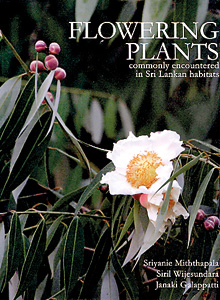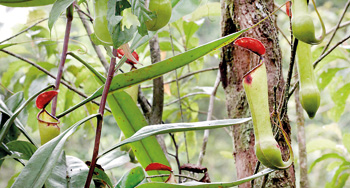It’s that time of year when Colombo, nay the whole country, is in bloom. We glimpse the bursts of colour while on the road, perhaps in our very own gardens - the purple spikes of the Queen’s Flower, the dangling yellow clusters of the Ehela, or the brilliant orange of the African Tulip Tree.
Sri Lanka has an abundance of flowering plants, some 4,000 species we are told, notwithstanding the introduced ones yet how many could we even begin to name – a dozen or two? For those of us who frequently have had to rue our inability to identify some of these beauties that we encounter in our daily life, here is a book to rectify any such lack of knowledge.
The authors refer to their work as a celebration of the flowering plants of this country and stress that what they have compiled here is a selection, not a field guide.
Well known biologists all three, with solid credentials, they have chosen to keep the book simple, restricting the scientific terminology to a bare minimum, instead using their considerable ability as science writers to present the material in an easily assimilable form. The result- a refreshingly interesting and useful book.
A brief section on Recognising Plants describes how one can easily identify a particular plant- what to look for such as the shape of the crown, the way a tree branches, its bark etc, in addition to the layman’s likely choice of leaves and flowers. Long forgotten botany lessons come to mind as we read of the difference between shrubs and herbaceous plants.
The latter ‘are smaller than shrubs and their main feature is that their stems are not woody. They do not necessarily have multiple stems. Often the above ground parts die at the end of a growing season.’ The examples cited are Arum lilies and grasses – it all becomes crystal clear.
Each plant/ tree is identified with its scientific name, common English name, Sinhala and Tamil names and the plant family. A short description accompanied by a picture helps fix it in the reader’s mind. Brief the accounts may be but they provide fascinating chunks of information. Writing of the Milkwood tree which has clusters of cascading greenish white flowers, the authors record that it is mentioned in the Mahawamsa during the time of King Dutugemunu (107-77 BC).
We learn that the Aegle marmelos or Beli is a member of the citrus family and that it is considered sacred by Hindus, that the goddess Lakshmi is believed to have offered a thousand Beli/Vilvam flowers every day to God Shiva; then that the name Banyan comes from the Banyas, Indian merchants from the Gujarati region, who used to sell their wares from under the shade of these spreading trees. The writing is lucid and entertaining besides – consider this description of the Madras Thorn: “This tree always looks as if it is having a bad hair day, as its foliage is so untidy” . Or that the poisonous Niyangala got its scientific name of ‘Gloriosa superba’ as two botanists on encountering it exclaimed simultaneously ‘Glorious’ and ‘Superb!’
It would have been easy to stick to the obvious trees and plants, but by grouping them- Plants of the Wet Zone, Plants of the Dry Zone, Coastal Plants, Aquatic Plants, Plants of Disturbed Areas, Parasitic Plants etc, the reader is given a wider sample to enjoy.
A careful selection of pictures has enhanced the book for no amount of detailed description could aid identification as a picture could. That many leading photographers, the likes of Gehan de Silva Wijeyeratne, Luxshmanan Nadaraja, Christopher Silva and Anu Weerasinghe of Studio Times are among the more than dozen names listed in the credits adds considerable value to the book.
The design by another heavyweight in the arts world Prof. Albert Dharmasiri is uncluttered and effective.
The writers state that their aim is to foster conservation through an appreciation and understanding of this wealth of flora which is an integral part of this country, now under threat from deforestation, climate change, pollution and the dangerous spread of alien invasive species. It is to their credit that hardly anyone after reading this book is likely to put it down without a humbling awareness of this great bounty we have been blessed with and as they put it, the consciousness of how vital it is to our own survival.
‘Flowering Plants’ is one in a series of ten books that the National Trust of Sri Lanka which, Dr. Roland Silva, its President tells us in the foreword has set out to produce; books related to their objectives that would be of popular interest. Though hardcover coffee table volumes, the Trust has kept them reasonably priced and hence affordable - a factor that must be appreciated in these days of escalating costs.
Flowering Plants will be launched on March 29 at 6.30 p.m. at the HNB auditorium, 22nd Floor HNB Towers 479, T,B, Jayah Mawatha, Colombo 10. It will be available at its prepublication price of Rs. 3000 until March 29 and thereafter at Rs. 3250 at the National Trust office, 407, Bauddhaloka Mw, Colombo 7. |



